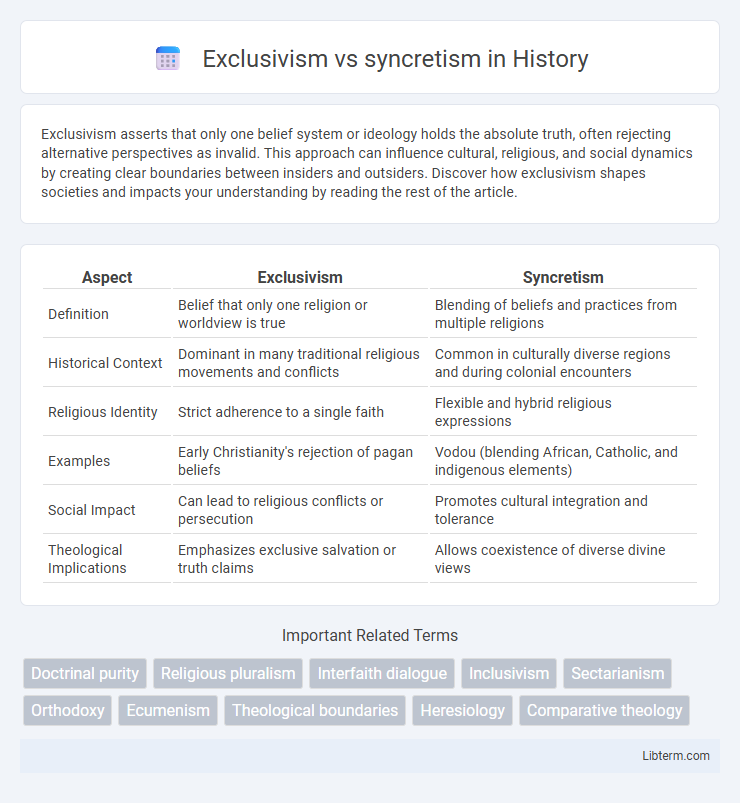Exclusivism asserts that only one belief system or ideology holds the absolute truth, often rejecting alternative perspectives as invalid. This approach can influence cultural, religious, and social dynamics by creating clear boundaries between insiders and outsiders. Discover how exclusivism shapes societies and impacts your understanding by reading the rest of the article.
Table of Comparison
| Aspect | Exclusivism | Syncretism |
|---|---|---|
| Definition | Belief that only one religion or worldview is true | Blending of beliefs and practices from multiple religions |
| Historical Context | Dominant in many traditional religious movements and conflicts | Common in culturally diverse regions and during colonial encounters |
| Religious Identity | Strict adherence to a single faith | Flexible and hybrid religious expressions |
| Examples | Early Christianity's rejection of pagan beliefs | Vodou (blending African, Catholic, and indigenous elements) |
| Social Impact | Can lead to religious conflicts or persecution | Promotes cultural integration and tolerance |
| Theological Implications | Emphasizes exclusive salvation or truth claims | Allows coexistence of diverse divine views |
Introduction to Exclusivism and Syncretism
Exclusivism asserts that only one religious belief or tradition holds the absolute truth, often rejecting other faiths as invalid or incomplete. Syncretism blends elements from diverse religious or cultural traditions, creating a hybrid system that harmonizes different beliefs and practices. These contrasting approaches shape how individuals and communities understand religious identity and interfaith relations.
Defining Exclusivism: Core Principles
Exclusivism asserts that only one religion or belief system holds the absolute truth and the exclusive path to salvation, rejecting the validity of other faiths. This principle emphasizes the unique authority of sacred texts, doctrines, and religious experiences specific to that tradition. Exclusivism often underscores the necessity of adherence to its core tenets for spiritual fulfillment and eternal life.
Understanding Syncretism: Main Concepts
Syncretism involves blending diverse religious beliefs and practices into a cohesive system, emphasizing inclusivity and adaptation. This process often combines elements from multiple traditions, creating new interpretations that reflect cultural and historical contexts. Understanding syncretism requires recognizing its role in fostering religious pluralism and dynamic spiritual expression.
Historical Roots of Exclusivism
Historical roots of exclusivism trace back to early religious traditions that emphasized the singular truth of their doctrines, often distinguishing their beliefs from competing faiths. Ancient Judaism's strict monotheism and early Christianity's claim of salvation exclusively through Christ established foundational exclusivist perspectives. These traditions reinforced clear boundaries between insiders and outsiders, shaping centuries of theological and cultural exclusivism.
Evolution of Syncretism Across Cultures
Syncretism has evolved as a dynamic process where distinct religious and cultural beliefs merge, forming new, hybrid systems that reflect historical interactions and social integrations. This evolution is evident in practices such as Afro-Caribbean Vodou, which blends African religious elements with Christianity, and in the fusion of indigenous beliefs with Catholicism in Latin America. The continuous adaptation of syncretism highlights its role in cultural resilience and transformation, distinguishing it from exclusivism's rigid doctrinal boundaries.
Exclusivism in Religion and Philosophy
Exclusivism in religion asserts that only one particular faith or belief system holds the absolute truth, often rejecting the validity of other religious perspectives. Philosophically, exclusivism emphasizes a clear boundary between true doctrines and false beliefs, maintaining that salvation or enlightenment is attainable solely through adherence to a specific religion. This approach contrasts with syncretism by prioritizing doctrinal purity and exclusive truth claims over blending diverse spiritual ideas.
Syncretism’s Influence on Societal Integration
Syncretism significantly enhances societal integration by blending diverse religious and cultural beliefs, fostering mutual respect and understanding among different groups. This fusion of traditions reduces social conflicts and creates a cohesive community identity, promoting peaceful coexistence within multicultural societies. The dynamic interchange of ideas in syncretism supports greater inclusivity, which strengthens social bonds and collective harmony.
Comparative Analysis: Strengths and Weaknesses
Exclusivism emphasizes clear doctrinal boundaries, ensuring religious identity and preserving theological purity, but risks fostering intolerance and limiting interfaith dialogue. Syncretism promotes inclusivity and adaptability by blending diverse religious beliefs, enhancing cultural integration and understanding, though it may dilute core doctrines and cause confusion among adherents. Comparative analysis reveals exclusivism's strength in maintaining tradition contrasts with syncretism's flexibility, highlighting trade-offs between doctrinal clarity and cultural openness.
Contemporary Debates: Exclusivism vs Syncretism
Contemporary debates on exclusivism versus syncretism center on the boundaries between religious truth claims and cultural integration. Exclusivism asserts that only one faith holds absolute truth, rejecting doctrinal blending, while syncretism promotes harmonizing diverse religious beliefs to foster tolerance and dialogue. These debates often address challenges in globalization, where increasing interfaith interactions demand a balance between preserving religious identity and embracing pluralism.
Future Implications and Global Perspectives
Exclusivism, which asserts a single truth claim, may lead to increased interreligious tension and hinder global cooperation as societies become more diverse. Syncretism promotes blending beliefs, fostering intercultural dialogue and potentially easing conflicts, but risks diluting core religious identities. Future global dynamics will likely hinge on balancing exclusivist conviction with syncretic adaptability to sustain peace and pluralism.
Exclusivism Infographic

 libterm.com
libterm.com